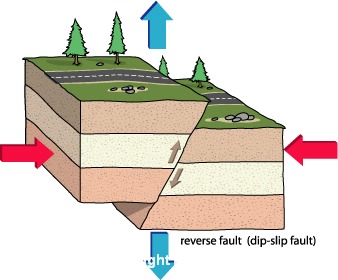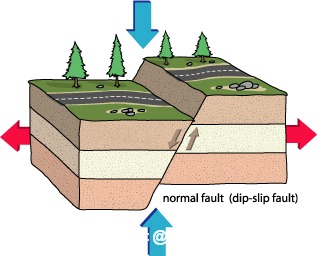Geologic fault
|
|
In geology, faults are discontinuities (cracks) in the Earth's crust that are the result of differential motion within the crust. Faults are the source of many earthquakes that are caused by slippage vertically or laterally along the fault. The largest examples are at tectonic plate boundaries, but many small faults are known to exist that are far from active plate boundaries.
The two sides of a fault are called the hanging wall and footwall. By definition, the fault always dips away from the footwall. Faults can be categorized into three groups: normal faults, transform (or strike-slip) faults and reverse (or thrust) faults. For all naming distinctions, it is the orientation of the original dip and movement of the fault as it was active which must be considered, and not the present day orientation, which may have been altered by local or regional folding or tilting.
Fault types
A normal fault occurs when the crust is in tension. The hanging wall moves downwards relative to the footwall. The depressed ground between two parallel normal faults is called a graben. A ridge between two parallel normal faults is called a horst. Low-angle normal faults with regional tectonic significance may be designated detachment faults.
A reverse fault is the opposite of a normal fault - the hanging wall moves up relative to the footwall. Reverse faults are indicative of compressional forces and shortening of the local crust. The dip of a reverse fault is relatively steep, greater than 45?.
A thrust fault has the same sense of motion as a reverse fault, but with the dip of the fault plane at less than 45?.
In the image below, you see a normal fault at left. A reverse fault is the same, except the hanging wall moves up instead of down. At right, you see a thrust fault.
Strike-slip faults
The fault surface is usually near vertical and the footwall moves either left or right or laterally with very small vertical motion. Strike-slip faults with left-lateral motion are also known as sinistral faults Those with right-lateral motion are also known as dextral faults. A special class of strike-slip faults are the transform faults which are a plate tectonics feature related to spreading centers such as mid-ocean ridges.


